Multi-Load Mode Analysis for Electric Vehicle Wireless Supply System
Abstract
:1. Introduction
2. The Wireless Supply System for EV
2.1. The System Topology
2.2. The Model of the Multi-Load System
3. The Stability Analysis of the Multi-Load System
4. The Magnetic Coupler
4.1. The Structure of the Supply Coil
4.2. The Characteristic of the Magnetic Field
5. Simulation and Experiment
6. Conclusions
Author Contributions
Funding
Conflicts of Interest
References
- Wei, X.; Wang, Z.; Dai, H. A Critical Review of Wireless Power Transfer via Strongly Coupled Magnetic Resonances. Energies 2014, 7, 4316–4341. [Google Scholar] [CrossRef] [Green Version]
- Wang, C.S.; Covic, G.A.; Stielau, O.H. Power Transfer Capability and Bifurcation Phenomena of Loosely Coupled Inductive Power Transfer Systems. IEEE Trans. Ind. Electron. 2004, 51, 148–157. [Google Scholar] [CrossRef]
- Sun, L.; Tang, H.; Zhang, Y. Determining the Frequency for Load-Independent Output Current in Three-Coil Wireless Power Transfer System. Energies 2015, 8, 9719–9730. [Google Scholar] [CrossRef] [Green Version]
- Choi, S.; Huh, J.; Lee, W.Y. New Cross-Segmented Power Supply Rails for Roadway-powered Electric Vehicles. IEEE Trans. Power Electron. 2013, 28, 5832–5841. [Google Scholar] [CrossRef]
- Budhia, M.; Boys, J.T.; Covic, G.A. Development of a Single-Sided Flux Magnetic Coupler for Electric Vehicle IPT Charging Systems. IEEE Trans. Ind. Electron. 2013, 60, 318–328. [Google Scholar] [CrossRef]
- Tavakoli, R.; Pantic, Z. Analysis, Design and Demonstration of a 25-kW Dynamic Wireless Charging System for Roadway Electric Vehicles. IEEE J. Emerg. Sel. Top. Power Electron. 2017, 1–16. [Google Scholar] [CrossRef]
- Liu, C.; Ge, S.; Guo, Y.; Li, H. Double-LCL Resonant Compensation Network for Electric Vehicles Wireless Power Transfer: Experimental Study and Analysis. IET Power Electron. 2016, 9, 2262–2270. [Google Scholar] [CrossRef]
- Huh, J.; Lee, S.W.; Lee, W.Y. Narrow-Width Inductive Power Transfer System for Online Electrical Vehicles. IEEE Trans. Power Electron. 2011, 26, 3666–3679. [Google Scholar] [CrossRef]
- Wang, Z.; Wei, X.; Dai, H. Nested Three-Layer Optimization Method for Magnetic Coils used in 3 kw Vehicle-mounted Wireless Power Transfer System. IET Power Electron. 2016, 9, 2562–2570. [Google Scholar] [CrossRef]
- Pantic, Z.; Bai, S.; Lukic, S.M. Inductively Coupled Power Transfer for Continuously Powered Electric Vehicles. In Proceedings of the IEEE Vehicle Power Propulsion Conference, Dearborn, MI, USA, 7–10 September 2009; IEEE: Piscataway, NJ, USA, 2009; pp. 1271–1278. [Google Scholar]
- Jang, Y.J.; Suh, E.S.; Kim, J.W. System Architecture and Mathematical Models of Electric Transit bus System Utilizing Wireless Power Transfer Technology. IEEE Syst. J. 2016, 10, 495–506. [Google Scholar] [CrossRef]
- Ahn, D.; Hong, S. Effect of Coupling between Multiple Transmitters or Multiple Receivers on Wireless Power Transfer. IEEE Trans. Ind. Electron. 2013, 60, 2602–2613. [Google Scholar] [CrossRef]
- Lei, Y.; Zhang, J.; Song, K. Stability Analysis of Multi-load Inductively Coupled Power Transfer System. Trans. China Electron. Soc. 2015, 30, 187–192. [Google Scholar]
- Wesemann, D.; Witte, S.; Michels, J.S. Effects of multiple loads in a contactless, inductively coupled linear power transfer system. In Proceedings of the International Conference on Electrical and Electronics Engineering, Bursa, Turkey, 5–8 November 2009; IEEE: Piscataway, NJ, USA, 2009; pp. 54–59. [Google Scholar]
- Shin, J.; Shin, S.; Kim, Y. Design and Implementation of Shaped Magnetic-resonance-based Wireless Power Transfer System for Roadway-powered Moving Electric Vehicles. IEEE Trans. Ind. Electron. 2014, 61, 1179–1192. [Google Scholar] [CrossRef]
- Su, Y.G.; Zhang, S.; Hu, C.; Tang, C.S.; Zhou, W. An Embeddable Transmitter Coil Applied to Electric Vehicles Powered by IPT System. Int. J. Appl. Electromagnet. Mech. 2016, 50, 627–636. [Google Scholar] [CrossRef]
- Liu, S.Q.; Tan, J.P.; Xue, S.H. Analysis on Coupling Mechanism Characteristics of Multi-load Wireless Power Transmission System. Autom. Electr. Power Syst. 2016, 40, 84–90. [Google Scholar]
- Raabe, S.; Covic, G.A. Practical Design Considerations for Contactless Power Transfer Quadrature Pick-ups. IEEE Trans. Ind. Electron. 2013, 60, 400–409. [Google Scholar] [CrossRef]
- Li, H.C.; Wang, K.P.; Huang, L. Dynamic Modeling Based on Coupled Modes for Wireless Power Transfer Systems. IEEE Trans. Power Electron. 2015, 30, 6245–6353. [Google Scholar] [CrossRef]
- Tang, C.S.; Sun, Y.; Dai, X.; Wang, Z.H.; Su, Y.G.; Hu, A.G. Analysis of Multiple Resonant Operating Points and Their Autonomous Oscillation Stabilities in Inductive Power Transfer System. Acta Phys. Sin. 2011, 60, 1–9. (In Chinese) [Google Scholar]

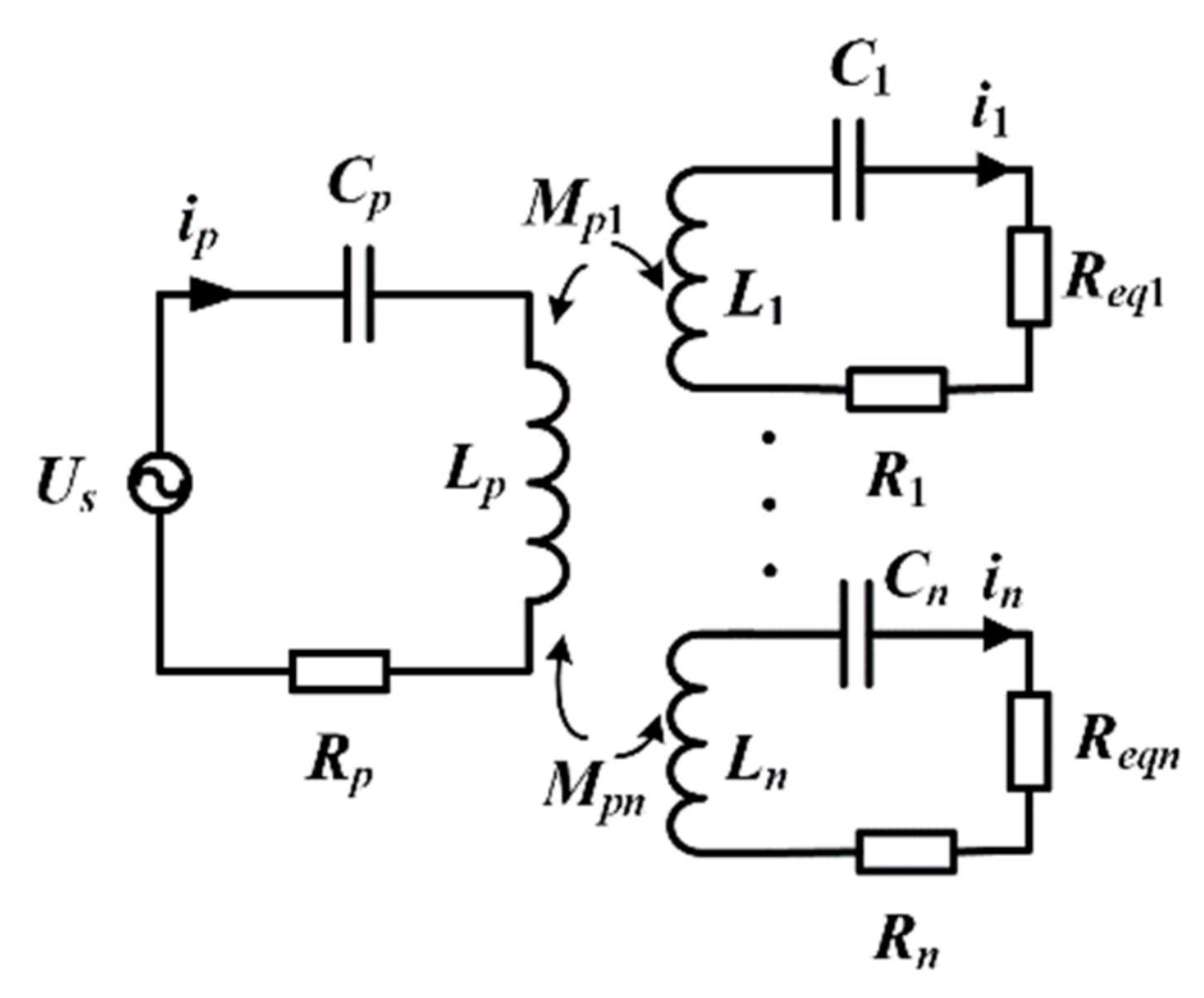

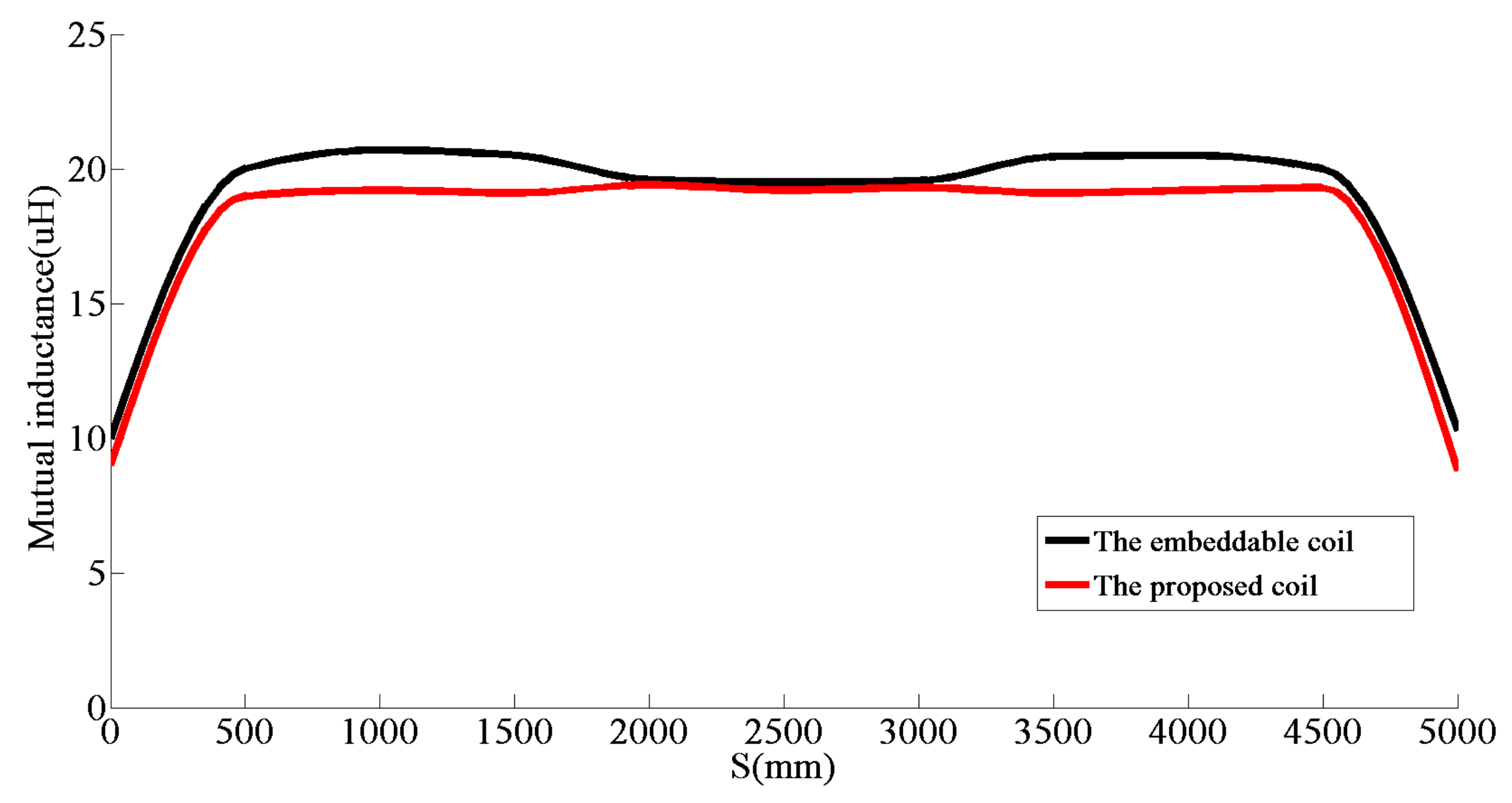

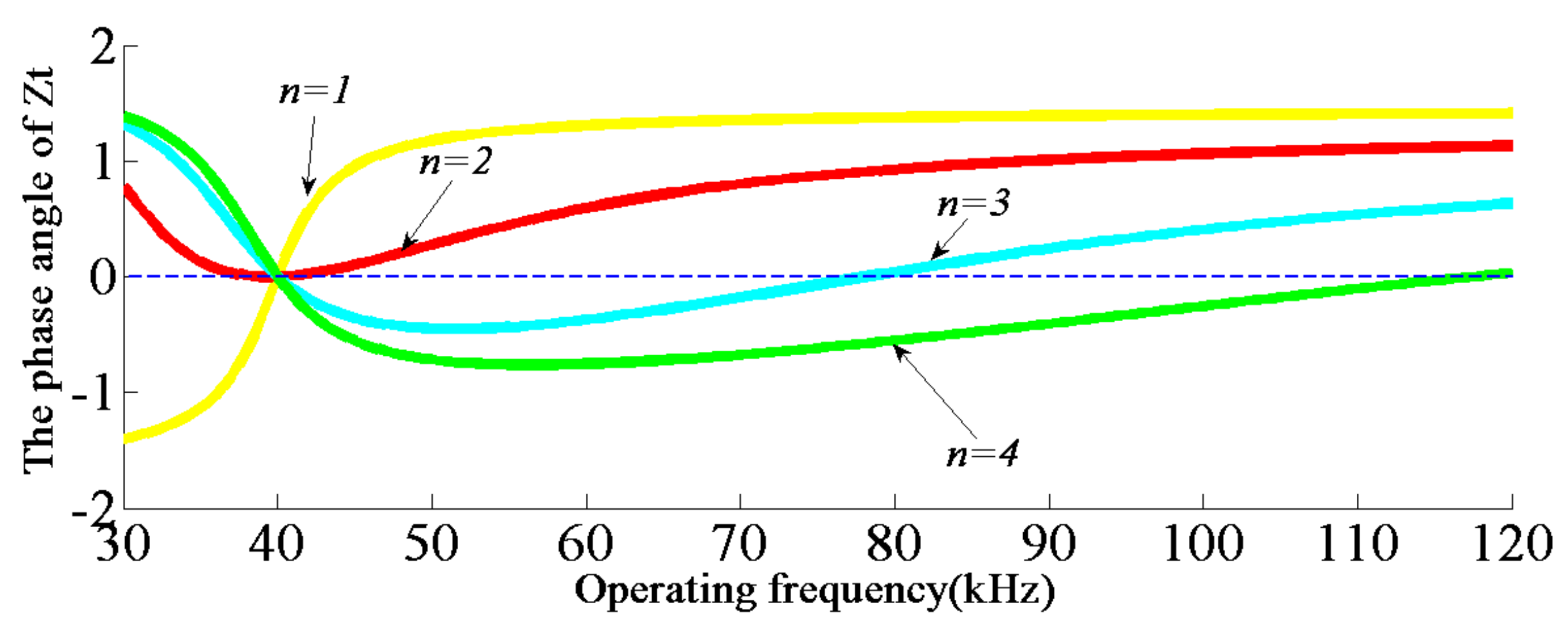
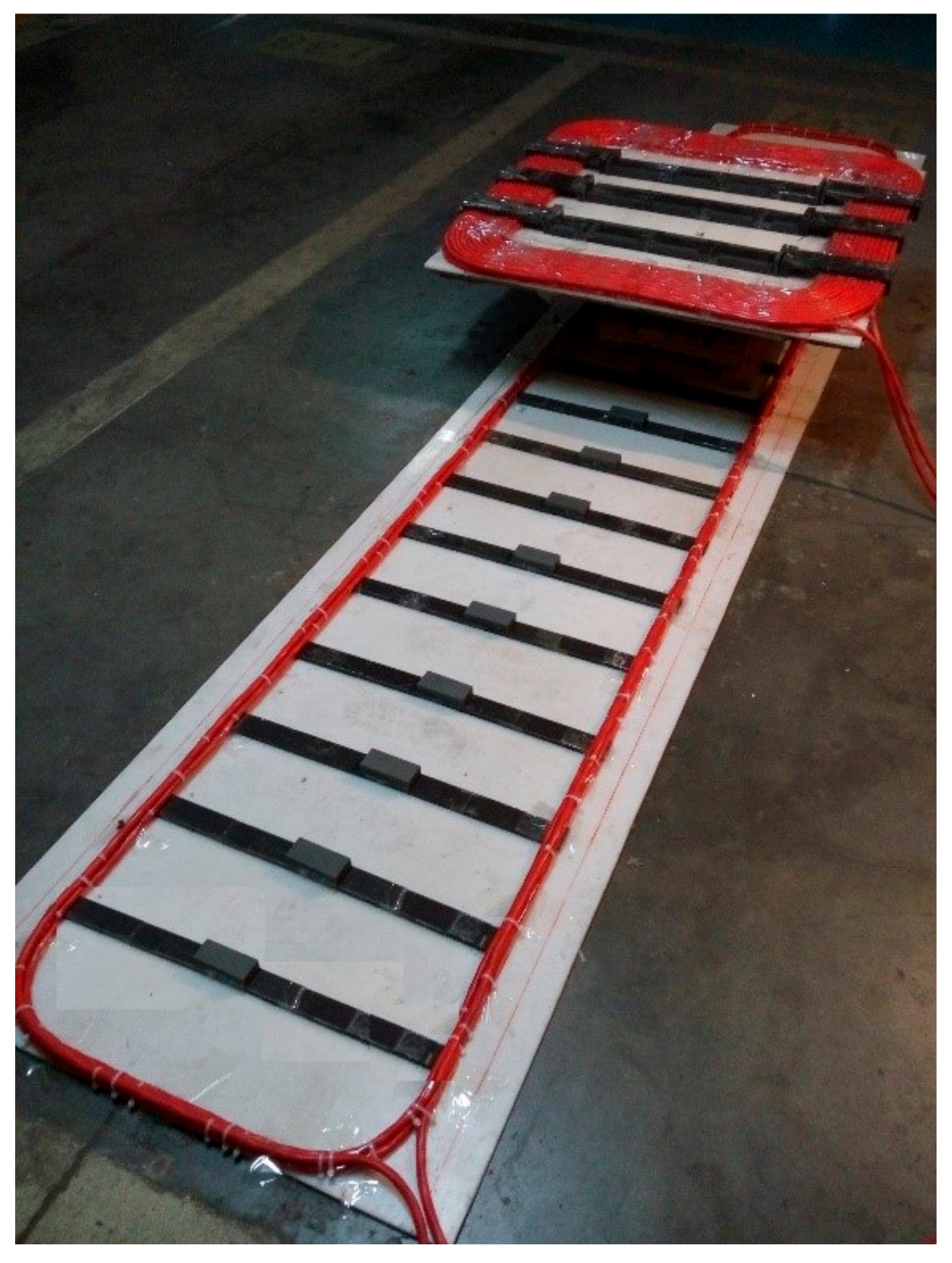
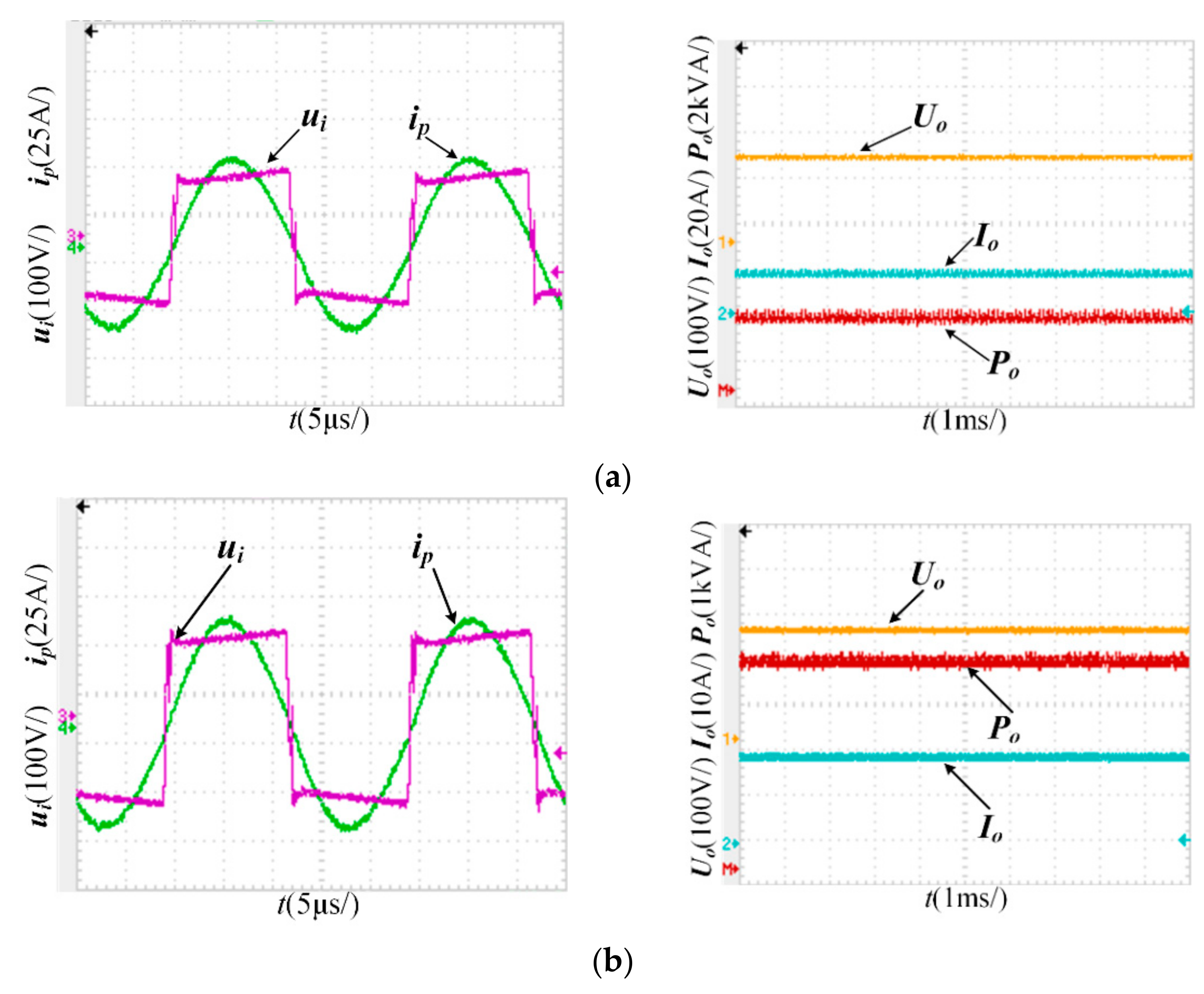
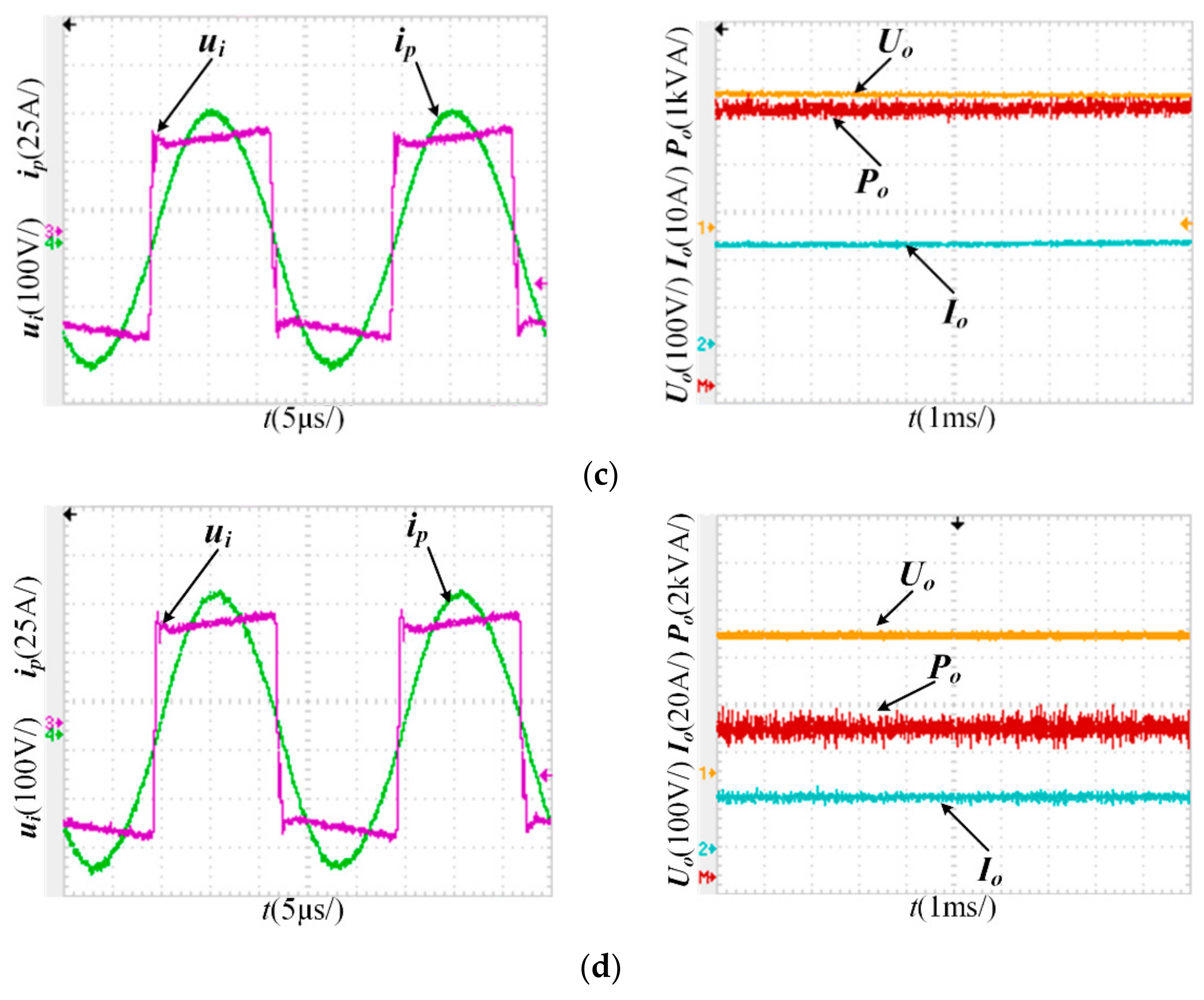
| The L-Shaped Coil | The Embeddable Coil | The Secondary Coil | |||
|---|---|---|---|---|---|
| Parameters | Values | Parameters | Values | Parameters | Values |
| l/mm | 5000 | l/mm | 5000 | ls/mm | 900 |
| d/mm | 700 | d/mm | 700 | ws/mm | 700 |
| N | 3 | N | 6 | N | 20 |
| df/mm | 180 | N1 | 17 | - | - |
| Parameters | Values |
|---|---|
| Supply coil Lp | 100 μH |
| Internal resistance of supply coil Rp | 0.3 Ω |
| Primary resonant capacitor Cp | 158 nF |
| Secondary coil Li | 480 μH |
| Internal resistance of secondary coil Ri | 0.5 Ω |
| Secondary resonant capacitor Ci | 33 nF |
| Equivalent load resistance Reqi | 14.5 Ω |
| Operating frequency f | 40 kHz |
| Output Power (kW) | Coupling Efficiency | The Voltage Generated in the L-Shaped Coil (V) | The Voltage Generated in the Embeddable Coil (V) |
|---|---|---|---|
| 3.17 | 84.83% | 789.14 | 4103.53 |
| 4.58 | 84.81% | 942.45 | 4900.74 |
| 5.81 | 84.91% | 1068.11 | 5554.17 |
| 6.58 | 85.07% | 1143.51 | 5946.25 |
© 2018 by the authors. Licensee MDPI, Basel, Switzerland. This article is an open access article distributed under the terms and conditions of the Creative Commons Attribution (CC BY) license (http://creativecommons.org/licenses/by/4.0/).
Share and Cite
Jiang, C.; Sun, Y.; Wang, Z.; Tang, C. Multi-Load Mode Analysis for Electric Vehicle Wireless Supply System. Energies 2018, 11, 1925. https://doi.org/10.3390/en11081925
Jiang C, Sun Y, Wang Z, Tang C. Multi-Load Mode Analysis for Electric Vehicle Wireless Supply System. Energies. 2018; 11(8):1925. https://doi.org/10.3390/en11081925
Chicago/Turabian StyleJiang, Cheng, Yue Sun, Zhihui Wang, and Chunsen Tang. 2018. "Multi-Load Mode Analysis for Electric Vehicle Wireless Supply System" Energies 11, no. 8: 1925. https://doi.org/10.3390/en11081925




